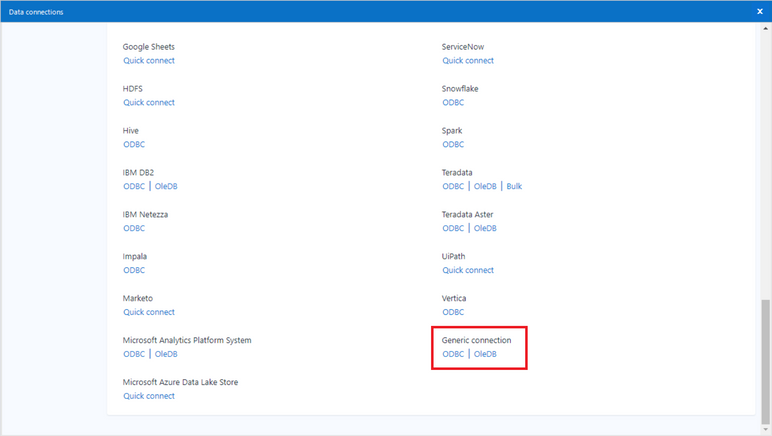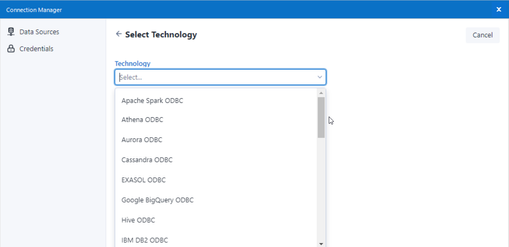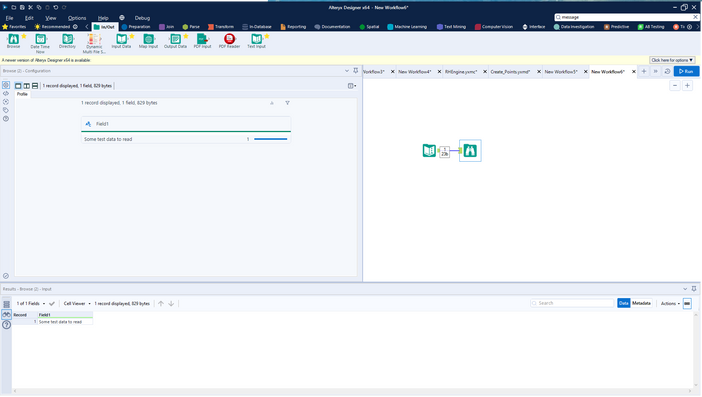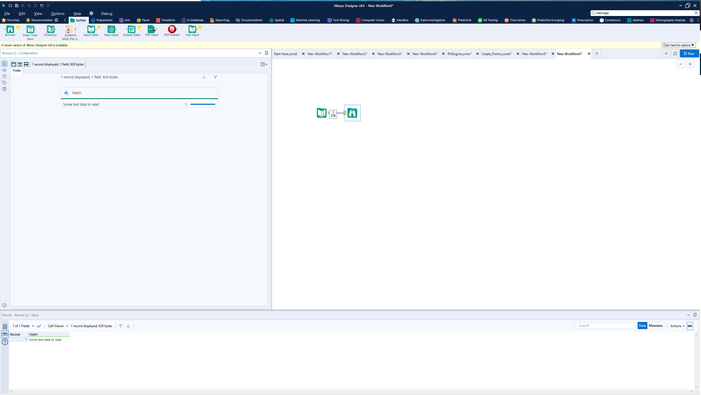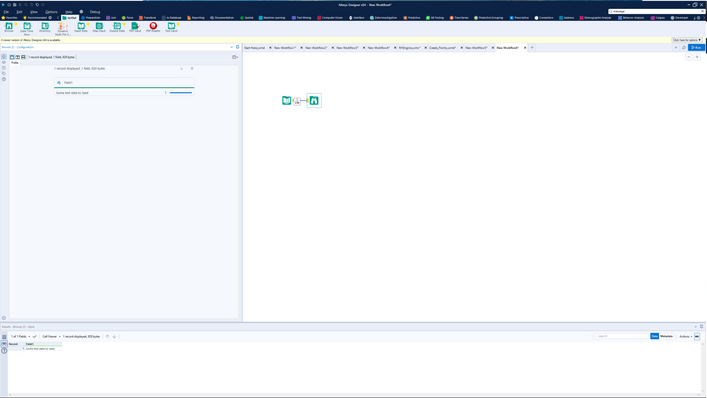Alteryx Designer Desktop Ideas
Share your Designer Desktop product ideas - we're listening!Submitting an Idea?
Be sure to review our Idea Submission Guidelines for more information!
Submission Guidelines- Community
- :
- Community
- :
- Participate
- :
- Ideas
- :
- Designer Desktop: Top Ideas
Featured Ideas
Hello,
After used the new "Image Recognition Tool" a few days, I think you could improve it :
> by adding the dimensional constraints in front of each of the pre-trained models,
> by adding a true tool to divide the training data correctly (in order to have an equivalent number of images for each of the labels)
> at least, allow the tool to use black & white images (I wanted to test it on the MNIST, but the tool tells me that it necessarily needs RGB images) ?
Question : do you in the future allow the user to choose between CPU or GPU usage ?
In any case, thank you again for this new tool, it is certainly perfectible, but very simple to use, and I sincerely think that it will allow a greater number of people to understand the many use cases made possible thanks to image recognition.
Thank you again
Kévin VANCAPPEL (France ;-))
Thank you again.
Kévin VANCAPPEL
There is "update:insert if new" option for the output data tool if using an ODBC connection to write to Redshift.
This option really needs to be added to the "amazon redshift bulk loader" method of the output data tool, and the write in db tool.
Without it means you are forced to use the "Delete and append" output which is a pain because then you need to keep reinserting data that you already have, slowing down the process.
Using the ODBC connection option of the output data tool to write to Redshift is not an option as it is too slow. Trying to write 200MB of data, the workflow runs for 20 minutes without any data reaching the destination table. End up just stopping the workflow.
Hello all,
Change Data Capture ( https://en.wikipedia.org/wiki/Change_data_capture ) is an effective way to deal with changes in a database, allowing streaming or delta functionning. Several technos, more or less intrusive, can be applied (and combined). Ex : logs reading.
Qlik : https://www.qlik.com/us/streaming-data/data-streaming-cdc
Talend : https://www.talend.com/resources/change-data-capture/
Best regards,
Simon
Tools should not error with Zero rows, often when working with macros it is possible to have a scenario where zero rows or columns is legitimate. Some tools are fine with this and some are not. In my case the Select Tool does not allow it so I have to create a Work around with a Text Input tool.
There is an extensive need from customers to be able to create emails but not send them (right away at least).
I'm in the banking sector and I have been seeing many banks using Alteryx and Alteryx server in their routines. Also, when it comes to sending automatic e-mails in this sector, its very risky. We need a "four eyes check" when dealing with clients information. Currently there is no workaround that could be applied to e-mail tool when used in Alteryx server as well.
My idea is to simply create a button "Save in draft" in e-mail tool to create an .eml format as output. This .eml can be read by outlook and thus, it creates a draft.
This also should be taken into account when dealing with drafts in alteryx server, so that any user can run the workflow and get the desired draft.
Thanks
Hello all,
I really love the DCM feature present in the last two releases. However, I have noticed the Generic ODBC Connection is missing :
Classic Connection Manager :
Data Connection Manager :
Best regards,
Simon
I would like to request the ability to connect to a SharePoint List to bring data from and write data to via Windows Authentication. Currently, the only way to connect to a SharePoint List is via username/password which does not work for our current environment.
Hello!
Currently i develop on a 2560 x 1440 monitor, and it is great for development of Alteryx workflows.
However, from an accessibility perspective (and for demonstration purposes), the whole of the Alteryx Interface text and icons are far too small for anyone to read. For instance, this is what Designer looks like at the most common monitor size, 1920 x 1080:
And at my native resolution (2560 x 1440)
And 4k resolution, for comparison:
As you will notice - virtually everything is smaller, and unreadable at higher resolutions. It doesn't appear that this is a setting within Alteryx, and so I have to resort to windows settings to change the size:
Or as @CharlieS mentions here change the size of text across all applications.
It would be useful within Alteryx to have a 'scaling' slider/dropdown, so I do not have to change the resolution or size of applications within windows, to be able to easy read or demonstrate data from Alteryx Designer.
Thanks,
TheOC
At the moment, at least for Postgres and ODBC connections, the DCM only supports a names DSN that must be installed on each machine running Designer or Server. However, the ODBC admin function is admin only within my company, which makes DCM more trouble than it is worth to use.
Connection strings work well in the workflows, have been implemented on the gallery before, and do not require access to the ODBC admin to implement. Could DCM please be improved to support native connection strings?
Idea: I need a function that given two dates, will return the number of business days between them. I need to know the # of business days between when a sales order is placed and when it ships to the customer. I'm in the US, so I would want to not count Saturdays, Sundays, and US Holidays, but I can foresee others wanting the option to change to other calendars or ignore holidays.
There are a couple of posts on this in the community, but everything I've found so far is too laborious to implement or not robust.
I recently did some extensive work on using the download tool to invoke Restful Web Services. A lot of the initial effort was around ensuring that the data being passed in the header and body for the request was as the service required. Following review of experiences on the community I used a tool called Fiddler to directly view what was being sent to identify the problems in my transformations of the data going into the Download tool. The idea is that the raw HTTP request and reply messages are available directly in Alteryx in the Results window when running a workflow, preventing the need to use another tool.
Hey Alteryx Community,
I think Alteryx uses the Tableau SDK to create tableau data extracts, TDE's. Since Tableau 10.3, there is functionality to connect to spatial files in Tableau (.shp). These shapefiles can be converted to an tableau data extract within Tableau. The tableau SDK has this functionality as well, but Alteryx does not support it yet. The suggestion is to add this functionality. See https://onlinehelp.tableau.com/current/api/sdk/en-us/SDK/tableau_sdk_samples.htm for the SDK link.
Spatial TDE's are way smaller (3gb .shp went to 140mb TDE) and way faster.
Thanks,
Marco
I have need to Unique my data on all fields. However, I do not know all the fields that will be in my data because of a Dynamic Select tool (or in some cases a Cross Tab tool). The Unique tool defaults to having any new fields be unchecked in its configuration. Without finding some work around, I will be unable to schedule this workflow or turn it into an app for use on the Gallery without risking duplication caused by the Unique tool that fails to capture new/different fields that may come through the data.
To solve this problem and be consistent with other tools in Alteryx, the following features need to be added to the Unique tool:
- The user should be able to check a "Dynamic or Unknown Fields" option that will enable Alteryx to include any new fields in the data as part of the Unique (or any fields that have their names changed).
- If a field that was checked in the Unique tool before no longer exists, it should appear yellow (like the missing fields in the Select tool) and produce a warning in the Results window. The option to "Forget all missing fields" will also need to be added.
Similar to how the Join tool allows to "Select all Left" or "Select all Right" I'd like to see the Append Fields tool have an option to select all source or select all target. Same for deselect.
It would be nice if AWS Glue had first class support in Alteryx. This would allow Alteryx to more seamlessly connect to data sources defined in the Glue metastore catalog. That alone would be handy and save on extra book-keeping. AWS Glue also has an ETL language for executing workflows on a managed Spark cluster, paying only for use. Integrating this big data tool with Alteyrx would be interesting as a way to execute in-database Spark workflows without the extra overhead of cluster management or Alteyrx connectivity
One of the larger challenges that my organization's users have when moving from creating workflows in Designer to uploading them to the Gallery is dependencies and pathing. Given the fact that the server does not mount drives (e.g. G:\), but requires UNC pathing, this creates an additional step and hurdle for new users. Furthermore, understanding the difference between packaging an asset with a workflow and pathing live also introduces yet another consideration to check for. While Alteryx provides the ability to set each of these, I think that there is an opportunity from a UI perspective to better consolidate and expose dependency/asset management.
I only recently discovered the Workflow Dependencies window after using the product for two years, and probably should have known it was there, but I feel like tucking that dialog into Advanced Options is kind of a strange place to put it. In that menu, you have both User/System connection management, as well as Workflow-specific encryption and dependency management. Maybe I’m alone here, but I only think of hitting User Settings and Advanced Options when I am setting environment settings, not working on a workflow.
In order to effectively manage assets when creating a gallery workflow, I currently have to:
- Ensure that all of my Inputs are UNC pathed or go into the Dependency Manager to switch them all
- Uncheck any “live” file connections by clicking on the input and unchecking it in the Assets properties window. Even getting this property to show up is a bit of a pain point by telling my users they have to go to Edit User Settings-->Advanced-->Display Asset Management in Properties Window. Note that unchecking an input from the Edit button in the Workflow Dependencies window does not uncheck the asset (which seems like a bug to me).
- I can check on my assets when I go to save a workflow to the gallery, but that only saves it to the gallery copy, not the source workflow. In order to switch UNC pathing or asset inclusion in the original workflow, I have to go back to steps A and B.
Ultimately, I feel like a better user experience would be to consolidate each of these into a Workflow Dependencies & Assets dialog box that is comprehensive and consistent. This dialog box could be accessed either from an intuitive menu in Designer or from the Save As menu when uploading to Gallery, and the user would have the option to save the settings back to the source workflow. Furthermore, a validation step could be added to let the user know before uploading to the gallery that they have non-UNC paths and they could have the option to switch it prior to upload.
Hi Alteryx
I understand why you need to keep bloat away from the product and have tools available to download instead, it means you can iterate and update them outside the usual cadence cycles. But please, for the love of everything holy, make it easier to find them and download them.
Let me give you an example of downloading the Google Sheets Input Tool:
1. I type in the amazing search and find a help article on it, so far so good:
2. I am pointed to the Gallery:
3. I click but where do I look? I need to revert to the tiny search in the top left. This isn't obvious for new users
4. but the search doesn't come top, how some of these search results get in above what I need I have no idea. I get to page 4 before I see something that looks like what I need before I realise it is a third party tool having installed it. I come back, can't find the tool and so give up. If it's there somewhere then it needs to be more obvious.
5. I google - I finally find (third item) something that's more useful but only because I know what I'm looking for
6. I run the workflow, then run it again as per the instructions. At this point I'm losing the will to live tbh.
7. Finally something that looks useful, I bang the huge download button twice and wonder why it didn't work.
9. I read the text and realise I need to click the link - finally I have the installer.
That was a five minute job. It was painful. And I'm a seasoned Alteryx user. If I was a new user, I'd have given up at step 2 or 3.
But what was the thing I downloaded in Step 8? A set of release notes and links....why aren't these simply added to the help article I found in Step 1/2? It would surely be easier for you, and would be a whole lot easier for users. Why do we need this painful process?
Please please please make it easier for me to install new tools.
Connect to Azure SQL Database with Azure AD also with Multi-Factor Authentication is a crucial feature nowadays. The tool should be configurable by interface tools so we can change the database within the same Azure Database server.
There is a workaround to use ODBC for this but it does not support caching credentials and that's why problematic to use. The credential prompt is appearing every time we run the workflow. With ODBC it's also required to have a separate DSN for every database in the same server.
To make it easy for users there should be a native connector for this feature. The user experience should be easy as it's in an azure data lake connector.
Having the open / close ( expand / collapse ) button for the tool container in lhe top right corner implies that everytime a big container is expanded, to close it the user has to move the pointer to its new position, which sometimes mean scrolling / zooming out and then zooming in to locate it.
I suggest to locate that button in the top left corner by the side of the enable/disable switch or even a double click mechanism for open/close, which would enable to user to open, see what is inside the container, and close it without moving the mouse to locate the new location of the button.
Hi currently the s3 upload tool only allows file format of *.yxdb , *.json, *.csv and *.avro
In order to optimize loading to redshift, it would be good to have a few more functions
1. Ability to s3 upload with *.gz format
eg: Reading in a file using the input tool -> s3 upload tool (which has a gzip function with the following options - record limit, delimiter, UTF8)
http://docs.aws.amazon.com/redshift/latest/dg/t_loading-gzip-compressed-data-files-from-S3.html
2. Change max record limit, delimiter, UTF8 format
3. Change the objectName to 'take file/table name from field' with filename containing filename or part of filename similar to the 'Output tool'
Adrian
To avoid some errors occurring during upgrade or even installation, it would be great to add an option in the installer to go with a fresh installation (remove any previous Alteryx Designer).
If selected, option would:
- Warn users that everything Alteryx related is going to be deleted
- Generate a log of what is going to be removed
- Rename folders and registry keys listed there: https://community.alteryx.com/t5/Alteryx-Designer/Complete-Uninstall-of-Alteryx-Designer/ta-p/402897
(rename instead of delete to avoid "bad surprises")
A similar option could exist when one would like to uninstall Alteryx Designer.
This would remove the frustration of having to rely on a "white knight" when something happens in the middle of an upgrade or an installation.
Thanks,
PaulN
- New Idea 377
- Accepting Votes 1,784
- Comments Requested 21
- Under Review 178
- Accepted 47
- Ongoing 7
- Coming Soon 13
- Implemented 550
- Not Planned 107
- Revisit 56
- Partner Dependent 3
- Inactive 674
-
Admin Settings
22 -
AMP Engine
27 -
API
11 -
API SDK
228 -
Category Address
13 -
Category Apps
114 -
Category Behavior Analysis
5 -
Category Calgary
21 -
Category Connectors
252 -
Category Data Investigation
79 -
Category Demographic Analysis
3 -
Category Developer
217 -
Category Documentation
82 -
Category In Database
215 -
Category Input Output
655 -
Category Interface
246 -
Category Join
108 -
Category Machine Learning
3 -
Category Macros
155 -
Category Parse
78 -
Category Predictive
79 -
Category Preparation
402 -
Category Prescriptive
2 -
Category Reporting
204 -
Category Spatial
83 -
Category Text Mining
23 -
Category Time Series
24 -
Category Transform
92 -
Configuration
1 -
Content
2 -
Data Connectors
982 -
Data Products
4 -
Desktop Experience
1,605 -
Documentation
64 -
Engine
134 -
Enhancement
407 -
Event
1 -
Feature Request
218 -
General
307 -
General Suggestion
8 -
Insights Dataset
2 -
Installation
26 -
Licenses and Activation
15 -
Licensing
15 -
Localization
8 -
Location Intelligence
82 -
Machine Learning
13 -
My Alteryx
1 -
New Request
226 -
New Tool
32 -
Permissions
1 -
Runtime
28 -
Scheduler
26 -
SDK
10 -
Setup & Configuration
58 -
Tool Improvement
210 -
User Experience Design
165 -
User Settings
86 -
UX
227 -
XML
7
- « Previous
- Next »
- abacon on: DateTimeNow and Data Cleansing tools to be conside...
-
TonyaS on: Alteryx Needs to Test Shared Server Inputs/Timeout...
-
TheOC on: Date time now input (date/date time output field t...
- EKasminsky on: Limit Number of Columns for Excel Inputs
- Linas on: Search feature on join tool
-
MikeA on: Smarter & Less Intrusive Update Notifications — Re...
- GMG0241 on: Select Tool - Bulk change type to forced
-
Carlithian on: Allow a default location when using the File and F...
- jmgross72 on: Interface Tool to Update Workflow Constants
-
pilsworth-bulie
n-com on: Select/Unselect all for Manage workflow assets
| User | Likes Count |
|---|---|
| 32 | |
| 6 | |
| 5 | |
| 3 | |
| 3 |

